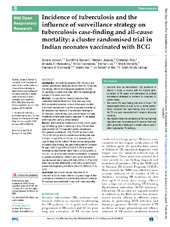| dc.contributor.author | Jenum, Synne | en_US |
| dc.contributor.author | Sumithra, Selvam | en_US |
| dc.contributor.author | Nelson, Jesuraj | en_US |
| dc.contributor.author | Christian, Ritz | en_US |
| dc.contributor.author | Hesseling Anneke, C | en_US |
| dc.contributor.author | Vicky, Cardenas | en_US |
| dc.contributor.author | Esther, Lau | en_US |
| dc.contributor.author | Mark, Doherty T | en_US |
| dc.contributor.author | Grewal, Harleen | en_US |
| dc.contributor.author | Mario, Vaz | en_US |
| dc.date.accessioned | 2019-05-29T11:51:34Z | |
| dc.date.available | 2019-05-29T11:51:34Z | |
| dc.date.issued | 2019 | |
| dc.Published | Jenum S, Sumithra, Nelson, Christian, Hesseling Anneke, Vicky, Esther, Mark, Grewal H, Mario. Incidence of tuberculosis and the influence of surveillance strategy on tuberculosis case-finding and all-cause mortality: A cluster randomised trial in Indian neonates vaccinated with BCG. BMJ Open Respiratory Research. 2018;5:e000304 | eng |
| dc.identifier.issn | 2052-4439 | |
| dc.identifier.uri | https://hdl.handle.net/1956/19812 | |
| dc.description.abstract | Introduction: Accurate tuberculosis (TB) incidence and optimal surveillance strategies are pertinent to TB vaccine trial design. Infants are a targeted population for new TB vaccines, but data from India, with the highest global burden of TB cases, is limited. Methods: In a population-based prospective trial conducted between November 2006 and July 2008, BCG-vaccinated neonates in South India were enrolled and cluster-randomised to active or passive surveillance. We assessed the influence of surveillance strategy on TB incidence, case-finding rates and all-cause mortality. Predefined criteria were used to diagnose TB. All deaths were evaluated using a verbal autopsy. Results: 4382 children contributed to 8164 person-years (py) of follow-up (loss to follow-up 6.9%); 749 children were admitted for TB evaluation (active surveillance: 641; passive surveillance: 108). The TB incidence was 159.2/100 000 py and the overall case-finding rate was 3.19 per 100 py (95% CI 0.82 to 18.1). Whereas, the case-finding rate for definite TB was similar using active or passive case finding, the case-finding rate for probable TB was 1.92/100 py (95% CI 0.83 to 3.78) with active surveillance, significantly higher than 0.3/100 py (95% CI 0.01 to 1.39, p=0.02) with passive surveillance. Compared to passive surveillance, children with active surveillance had decreased risk of dying (OR 0.68, 95%CI 0.47 to 0.98) which was mostly attributable to reduction of death from pneumonia/respiratory infections (OR 0.34, 95%CI 0.14 to 0.80). Conclusion: We provide reliable estimates of TB incidence in South Indian children <2 years of age. Active surveillance increased the case-finding rates for probable TB and was associated with reduced all-cause mortality. | en_US |
| dc.language.iso | eng | eng |
| dc.publisher | BMJ | eng |
| dc.rights | Attribution CC BY-NC | eng |
| dc.rights.uri | http://creativecommons.org/licenses/by-nc/4.0/ | eng |
| dc.title | Incidence of tuberculosis and the influence of surveillance strategy on tuberculosis case-finding and all-cause mortality: A cluster randomised trial in Indian neonates vaccinated with BCG | en_US |
| dc.type | Peer reviewed | |
| dc.type | Journal article | |
| dc.date.updated | 2019-01-24T09:13:51Z | |
| dc.description.version | publishedVersion | en_US |
| dc.rights.holder | Copyright 2018 The Author(s) | |
| dc.identifier.doi | https://doi.org/10.1136/bmjresp-2018-000304 | |
| dc.identifier.cristin | 1641483 | |
| dc.source.journal | BMJ Open Respiratory Research | |

